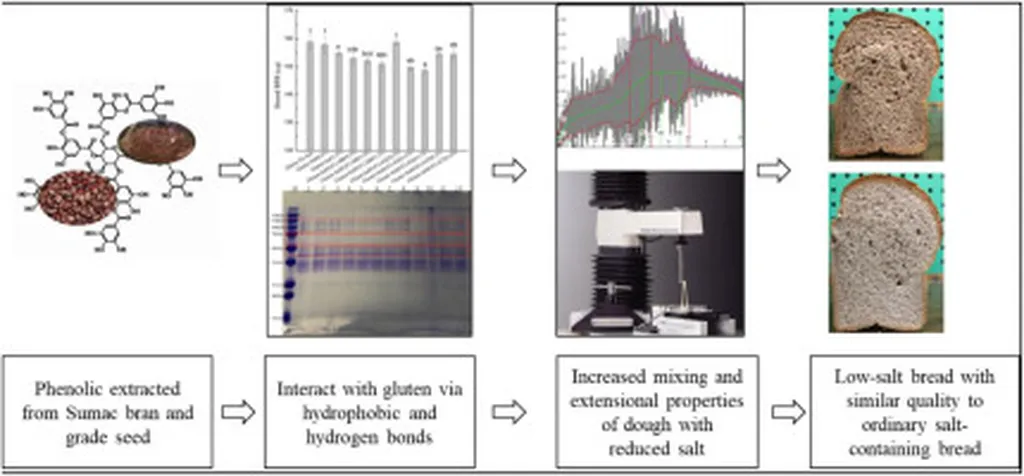In the quest to reduce salt content in bread without compromising quality, a team of researchers led by Jinrong Wang from the Tianjin Key Laboratory of Food Biotechnology at Tianjin University of Commerce has made a significant stride. Their study, published in the *Journal of Agriculture and Food Research* (translated as *Journal of Agriculture and Food Research*), explores the potential of phenolic compounds from sorghum bran, grape seed, and green tea to enhance dough rheology and bread quality in reduced-salt formulations.
The research team investigated the effects of phenolic compounds extracted from sumac sorghum bran (SBE), grape seed (GSE), and green tea (GTE) on the quality of bread made with only 0.8% salt. “We wanted to understand how these phenolic compounds interact with gluten and affect dough properties,” explained Wang. The team found that these compounds primarily interact with gluten through hydrogen bonding and hydrophobic interactions, with a particular affinity for high-molecular-weight proteins in glutenin macropolymers (GMP).
The findings revealed that adding 0.5%–1.0% SBE and 0.5% GSE significantly enhanced dough strength while maintaining bread quality comparable to that of bread made with 1.5% salt. “This is a promising result for the food industry, as it offers a viable approach to reducing salt content without sacrificing quality,” said Wang. However, the team also discovered that increasing GSE to 1% caused excessive dough strengthening, adversely impacting bread quality. Moreover, when GSE concentration reached 1.5%, the dough strength significantly decreased, leading to diminished bread quality.
Interestingly, the addition of GTE reduced dough strength and bread quality, likely due to its high total phenolic content and antioxidant properties. “While green tea extract showed some potential, its high phenolic content seemed to have a negative impact on dough strength and bread quality,” noted Wang.
This research opens up new possibilities for the food industry, particularly in the development of reduced-salt bread formulations. By incorporating phenolic compounds from sorghum bran and grape seed, bakers can potentially reduce salt content while maintaining the quality and texture of their products. “This study provides a foundation for further research and development in the field of reduced-salt bread formulations,” said Wang.
The commercial implications of this research are significant. As consumers increasingly demand healthier food options, the ability to produce high-quality, reduced-salt bread could give food manufacturers a competitive edge. Furthermore, the use of natural phenolic compounds aligns with the growing trend towards clean label and functional foods.
In the broader context, this research highlights the potential of phenolic compounds from various sources to enhance food quality and functionality. As the food industry continues to innovate, the insights gained from this study could pave the way for new and exciting developments in food science and technology. “We are excited about the potential applications of our findings and look forward to seeing how they can be utilized in the food industry,” concluded Wang.
With the publication of this study in the *Journal of Agriculture and Food Research*, the research team hopes to inspire further exploration into the use of phenolic compounds in food formulations. As the food industry continues to evolve, the insights gained from this research could play a crucial role in shaping the future of food production and consumption.

